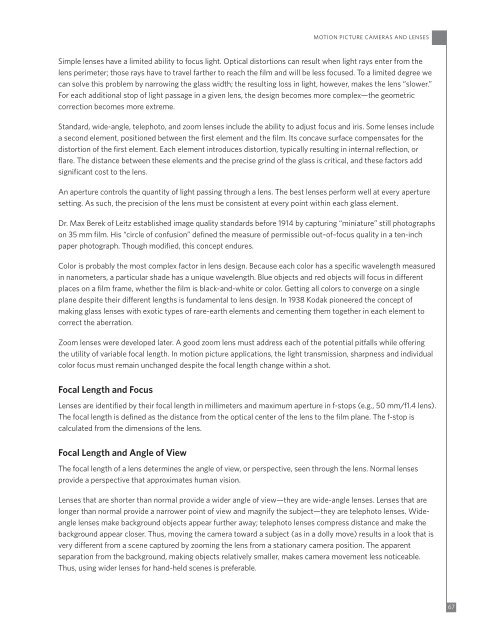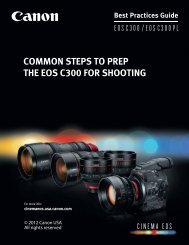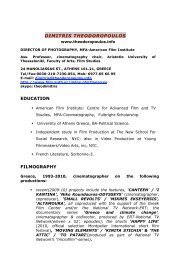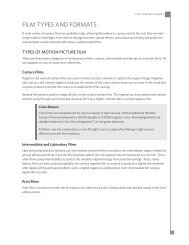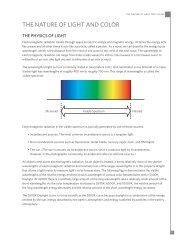You also want an ePaper? Increase the reach of your titles
YUMPU automatically turns print PDFs into web optimized ePapers that Google loves.
<strong>MOTION</strong> <strong>PICTURE</strong> <strong>CAMERAS</strong> <strong>AND</strong> <strong>LENSES</strong>Simple lenses have a limited ability to focus light. Optical distortions can result when light rays enter from thelens perimeter; those rays have to travel farther to reach the film and will be less focused. To a limited degree wecan solve this problem by narrowing the glass width; the resulting loss in light, however, makes the lens “slower.”For each additional stop of light passage in a given lens, the design becomes more complex—the geometriccorrection becomes more extreme.Standard, wide-angle, telephoto, and zoom lenses include the ability to adjust focus and iris. Some lenses includea second element, positioned between the first element and the film. Its concave surface compensates for thedistortion of the first element. Each element introduces distortion, typically resulting in internal reflection, orflare. The distance between these elements and the precise grind of the glass is critical, and these factors addsignificant cost to the lens.An aperture controls the quantity of light passing through a lens. The best lenses perform well at every aperturesetting. As such, the precision of the lens must be consistent at every point within each glass element.Dr. Max Berek of Leitz established image quality standards before 1914 by capturing “miniature” still photographson 35 mm film. His “circle of confusion” defined the measure of permissible out–of–focus quality in a ten-inchpaper photograph. Though modified, this concept endures.Color is probably the most complex factor in lens design. Because each color has a specific wavelength measuredin nanometers, a particular shade has a unique wavelength. Blue objects and red objects will focus in differentplaces on a film frame, whether the film is black-and-white or color. Getting all colors to converge on a singleplane despite their different lengths is fundamental to lens design. In 1938 <strong>Kodak</strong> pioneered the concept ofmaking glass lenses with exotic types of rare-earth elements and cementing them together in each element tocorrect the aberration.Zoom lenses were developed later. A good zoom lens must address each of the potential pitfalls while offeringthe utility of variable focal length. In motion picture applications, the light transmission, sharpness and individualcolor focus must remain unchanged despite the focal length change within a shot.Focal Length and FocusLenses are identified by their focal length in millimeters and maximum aperture in f-stops (e.g., 50 mm/f1.4 lens).The focal length is defined as the distance from the optical center of the lens to the film plane. The f-stop iscalculated from the dimensions of the lens.Focal Length and Angle of ViewThe focal length of a lens determines the angle of view, or perspective, seen through the lens. Normal lensesprovide a perspective that approximates human vision.Lenses that are shorter than normal provide a wider angle of view—they are wide-angle lenses. Lenses that arelonger than normal provide a narrower point of view and magnify the subject—they are telephoto lenses. Wideanglelenses make background objects appear further away; telephoto lenses compress distance and make thebackground appear closer. Thus, moving the camera toward a subject (as in a dolly move) results in a look that isvery different from a scene captured by zooming the lens from a stationary camera position. The apparentseparation from the background, making objects relatively smaller, makes camera movement less noticeable.Thus, using wider lenses for hand-held scenes is preferable.67


